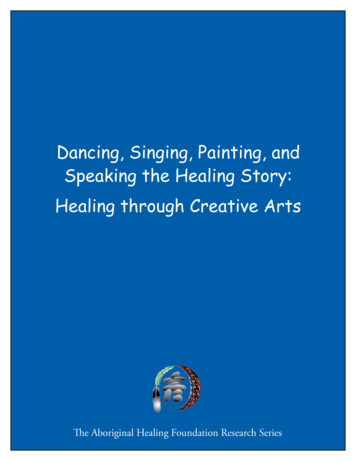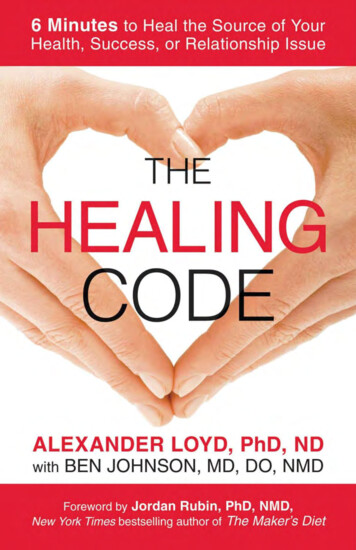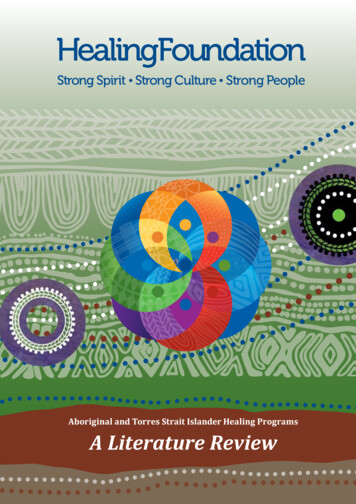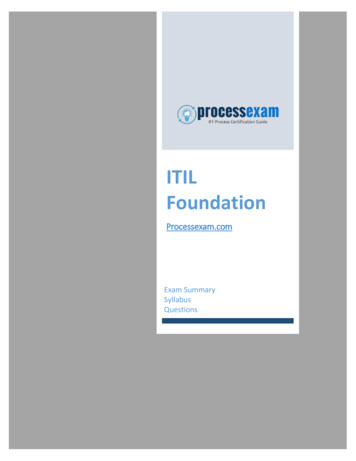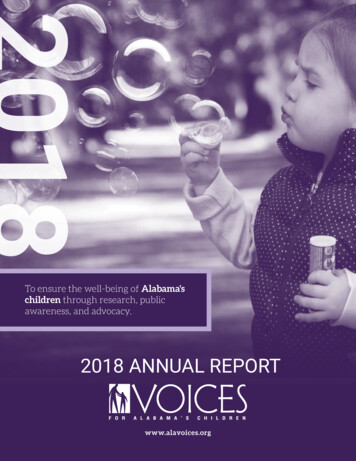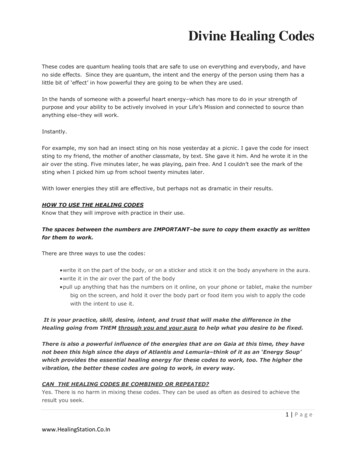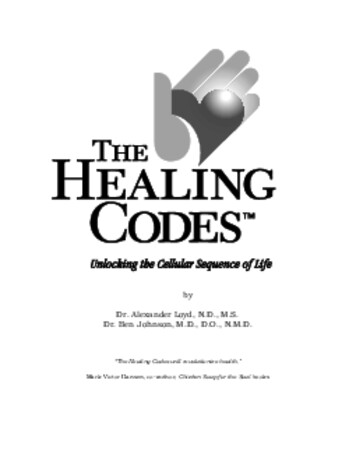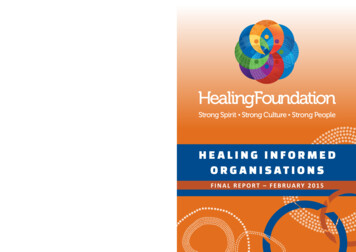
Transcription
HEALING INFORMEDORGANISATIONSFINAL REPORT – FEBRUARY 2015978-0-9871884-6-5
Urbis staff responsible for this report were:DirectorClaire GrealyIndigenous ConsultantKaren MilwardConsultantJoanna FarmerSuggested citationAboriginal and Torres Strait Islander Healing Foundation. (2015).Healing Informed Organisations.2
ContentsExecutive Summary. . . . . . . . . . . . . . . . . . . . . . . . . . . . . . . 41 Introduction. . . . . . . . . . . . . . . . . . . . . . . . . . . . . . . . . . . . . . . 51.1 This project. . . . . . . . . . . . . . . . . . . . . . . . . . . . . . . . . . . . . . . . . . . . . . . . . . . . . . . . . . . . . . . . . . . . . . . . . . . . . . . . . . . . . . . . . . . . . . . . . . . . . . . . . . . . . . . . . 51.2 Assumptions. . . . . . . . . . . . . . . . . . . . . . . . . . . . . . . . . . . . . . . . . . . . . . . . . . . . . . . . . . . . . . . . . . . . . . . . . . . . . . . . . . . . . . . . . . . . . . . . . . . . . . . . . . . . . . . 51.3 Methodology. . . . . . . . . . . . . . . . . . . . . . . . . . . . . . . . . . . . . . . . . . . . . . . . . . . . . . . . . . . . . . . . . . . . . . . . . . . . . . . . . . . . . . . . . . . . . . . . . . . . . . . . . . . . . . 51.4 This document. . . . . . . . . . . . . . . . . . . . . . . . . . . . . . . . . . . . . . . . . . . . . . . . . . . . . . . . . . . . . . . . . . . . . . . . . . . . . . . . . . . . . . . . . . . . . . . . . . . . . . . . . . . . . 52 What is healing?. . . . . . . . . . . . . . . . . . . . . . . . . . . . . . . . . 63 Trauma and healing in the organisational context. . 74 Trauma aware, healing informed organisations. 104.1 Developing a healing organisation. . . . . . . . . . . . . . . . . . . . . . . . . . . . . . . . . . . . . . . . . . . . . . . . . . . . . . . . . . . . . . . . . . . . . . . . . . . . . . . . . 135 Deciding to be a trauma aware, healing informed organisation. . . 155.1 Positive, healing oriented value system. . . . . . . . . . . . . . . . . . . . . . . . . . . . . . . . . . . . . . . . . . . . . . . . . . . . . . . . . . . . . . . . . . . . . . . . . . . 155.2 Procedures and policies that reflect the organisation’s values. . . . . . . . . . . . . . . . . . . . . . . . . . . . . . . . . . . . . . . . . . . . 165.3 Discipline to stick to clearly defined policies and procedures. . . . . . . . . . . . . . . . . . . . . . . . . . . . . . . . . . . . . . . . . . . . . 175.4 Good leadership at the management and governance levels. . . . . . . . . . . . . . . . . . . . . . . . . . . . . . . . . . . . . . . . . . . . . . 185.5 Review and monitoring of progress. . . . . . . . . . . . . . . . . . . . . . . . . . . . . . . . . . . . . . . . . . . . . . . . . . . . . . . . . . . . . . . . . . . . . . . . . . . . . . . . . 186 Healing aware, trauma informed organisation framework. 197 References. . . . . . . . . . . . . . . . . . . . . . . . . . . . . . . . . . . . . . . . 23Appendix A – case studies . . . . . . . . . . . . . . . . . . . . 24Gallang Place. . . . . . . . . . . . . . . . . . . . . . . . . . . . . . . . . . . . . . . . . . . . . . . . . . . . . . . . . . . . . . . . . . . . . . . . . . . . . . . . . . . . . . . . . . . . . . . . . . . . . . . . . . . . . . . . . . . . . 24Mununjali Jymbi Centre. . . . . . . . . . . . . . . . . . . . . . . . . . . . . . . . . . . . . . . . . . . . . . . . . . . . . . . . . . . . . . . . . . . . . . . . . . . . . . . . . . . . . . . . . . . . . . . . . . . . . . . 31Maari Ma Health. . . . . . . . . . . . . . . . . . . . . . . . . . . . . . . . . . . . . . . . . . . . . . . . . . . . . . . . . . . . . . . . . . . . . . . . . . . . . . . . . . . . . . . . . . . . . . . . . . . . . . . . . . . . . . . . . . 33FIGURES:Figure 1 – The assumed connections between positive practices and organisational effectiveness. . . . . . . . . . 10Figure 2 – Elements of a quality healing program. . . . . . . . . . . . . . . . . . . . . . . . . . . . . . . . . . . . . . . . . . . . . . . . . . . 11Figure 3 – Unhealthy organisations. . . . . . . . . . . . . . . . . . . . . . . . . . . . . . . . . . . . . . . . . . . . . . . . . . . 13Figure 4 – Healthy organisations. . . . . . . . . . . . . . . . . . . . . . . . . . . . . . . . . . . . . . . . . . . . . . . . . . . 14TABLES:Table 1 – Forms of lateral violence. . . . . . . . . . . . . . . . . . . . . . . . . . . . . . . . . . . . . . . . . . . . . . . . . . . 9Table 2 – Deciding to be a trauma aware, healing informed organisation. . . . . . . . . . . . . . . . . . . . . . . . . . . . . . 193
Executive SummaryThis report contributes to the work being undertaken by the Healing Foundation to promote healing informed organisations.It explores a number of issues, including the impact trauma can have on Aboriginal community controlled organisations, and thepotential for governance, management and service delivery frameworks that are trauma aware and healing informed.The report draws on an extensive review of literature, reports and articles that have a focus on the organisational impact oftrauma and the strategies that have been used to address this impact. A small set of case studies of Aboriginal organisations thathave implemented trauma aware and healing informed approaches also forms part of the report.The findings presented here have contributed to the development of a framework to assist governance and management groupsin engaging in the journey to being a trauma aware, healing informed organisation.BackgroundColonisation, intergenerational trauma and grief manifest in myriad ways. Beyond the impact on the individual, trauma can havea significant impact on the organisations where people work or volunteer, and from where they seek support. An organisationcan be adversely affected by the trauma informed behaviours of their staff, members of their governance group, and their clients.Without appropriate strategies, this combination can lead not only to stress and burnout for individuals, but have a significantimpact on the healthy functioning of organisations as a whole.Emerging practiceThe notion of a healing informed organisation is relatively new. An analysis of the literature suggests that applying the principlesof individual healing and mainstream positive organisational psychology to the governance, management and staffing structuresof a community controlled organisation can create a trauma aware, healing informed body. Doing this is preventative and healingfor both the organisation and its clients.The framework in this report, developed from the literature about organisational health, resilience, and healing practice, providesa scaffold for discussion and decision making within community controlled organisations. The development of the framework hasalso been informed by the work of three organisations that have already embarked on a journey to operate in a way that is healinginformed. Their stories are featured throughout the report, and collated as case studies in the appendix.A framework of four pillarsThere are four pillars to the framework, which outline key considerations for organisations wanting to develop a trauma awareand healing informed approach. These are:1. developing a positive, healing oriented value system that is shared and promoted across the organisation2. revising all procedures and policies to directly name and reflect the value system3. maintaining the discipline to consistently adhere to the policies and procedures4. ensuring the leadership at the management and governance levels is coherent with the value system.These pillars are discussed further in this report, and detailed in the framework (page 19).4
1 Introduction1.1 This projectThis report considers the role of healing informed governance in Aboriginal community controlled organisations (ACCOs). It is partof a suite of work being undertaken by the Healing Foundation to promote healing informed organisations.The Healing Foundation engaged Urbis to investigate the hypothesis that the healthy function of ACCOs can be negativelyimpacted by the trauma carried by the individuals who contribute to and are employed by the organisations. Given staff andgoverning board members are largely drawn from Indigenous communities shaped by trauma, this trauma can translate into theworkplace. Conversely, by instituting governance and management that are informed by healing principles, ACCOs may enjoy atrauma aware, healing informed organisational culture and increase their sustainability.This phase of work aims to develop a framework for trauma aware, healing informed organisations, including identifying theenablers of healthy responses to incidents and the levers for changing organisational culture.1.2 AssumptionsThe following assumptions underlie the work in this report: effective ACCOs can provide the most effective support for trauma-exposed clients when the organisation itself isfunctioning in a healthy and effective way trauma aware, healing informed organisations are not immune from disputes and crises, however, they respond toincidents in a resilient manner which in turn ensures the long-term sustainability of the organisation trauma aware, healing informed organisations have a flow-on effect to their surrounding community by practisinghealing informed governance.1.3 MethodologyThe evidence for this report was collected in two phases. The first was a literature review, which formed the basis of a discussionpaper presented to the Healing Foundation in August 2014.The second phase involved the development of case studies about the trauma aware and healing informed practices in threeACCOs. These case studies further inform the development of the framework included in this report.1.4 This documentThe next section of this report sets out a summary of healing. Section 3 discusses the impact of trauma in the organisationalcontext. Section 4 sets out the findings of the literature review into developing trauma aware, healing informed organisations. Insection 5, processes for achieving a trauma aware and healing informed organisation are laid out. This section draws on the casestudies, which are presented in Appendix A.5
2 What is healing ?‘Healing’ as a critical concept of social and emotional wellbeing began to be discussed in communities in the 1990s. The releaseof the Bringing them Home report in 1997 led to recognition of the Stolen Generations and the continuing negative impacts onindividuals and whole communities of government policies. It is now broadly recognised that unresolved trauma arose from thepolicies of past governments, resulting in the legacy of the Stolen Generations; and many of the problems prevalent in today’sAboriginal and Torres Strait Islander communities, such as substance misuse, mental illness and family violence, are themselvesrooted in a cycle of trauma.The journey to healing is recognised as a difficult one, because it exposes the person to their own trauma and pain as well as tothe pain of others:1Recognition of self, of others and as a collective that there are ‘issues’. That there is pain.That there is anger and hurt and sadness that stems from past events. And that thisanger, hurt and sadness is handed down like an unwanted legacy through the generationsof our people. Once there is that collective recognition, of both Aboriginal and TorresStrait Islander people and of all Australians, then begins the process of healing. Healingis a change. A change of attitude, a change of behaviours that have become entrenched. 2In Voices from the campfires, healing was described as holistic and involving ‘physical, social, emotional, mental, environmentaland spiritual wellbeing.’3 The report established four primary principles to support the healing journey:4 addressing the causes of community dysfunction, not its symptoms recognising the fundamental importance of Aboriginal and Torres Strait Islander ownership, definition, design andevaluation of healing initiatives designing initiatives based on Aboriginal and Torres Strait Islander worldviews, not western health understandingsalone strengthening and supporting initiatives that use positive, strength-based approaches.In addition to the concept of ‘healing as recovery’, healing also focuses on a positive view of wellness, rather than sickness.Traditional Aboriginal and Torres Strait Islander culture does not recognise mental or physical health issues as distinct medicalconditions.5 Wellness is considered in the context of family, community, culture, land and spirituality.6The aims of successful healing programs are to support Aboriginal and Torres Strait Islander people to reassert control over theirlives, ‘increasing social and cultural identity and self-esteem, cultural knowledge and skills and cultural connectedness.’7 Healinginvolves a renewal and affirmation of language, dance, story, music, art, identity and land.A strengths-based approach to health and social and emotional wellbeing draws on traditional and western approaches.8However, international research suggests that some Indigenous people perceive western health service providers as ‘an extensionof colonisation’.9 Culture, gender, cultural incompetence of service providers, mistrust and fear of repercussions, and negativeprevious experiences, are among the barriers to service provision for Aboriginal people in Australia.10123456789106Lane Jr et al. (2002)Aboriginal and Torres Strait Islander Healing Foundation Development Team (2009)Aboriginal and Torres Strait Islander Healing Foundation Development Team (2009)Aboriginal and Torres Strait Islander Healing Foundation Development Team (2009)Healing Foundation (2014a)Healing Foundation (2014a)Healing Foundation (2014a)Lane Jr et al. (2002); Healing Foundation (2014a)Healing Foundation (2014a)Healing Foundation (2014a; Health Workforce Australia (2014)
As a result, healing requires cultural awareness and the development of culturally safe environments for the exploration oftrauma and identity. The two terms are often used interchangeably, but have distinct meanings. Cultural safety is a more complexterm, but a culturally safe environment is most desirable for health services in their provision for Aboriginal and Torres StraitIslander people.Organisations, including the Healing Foundation, are developing important work to heal the systemic trauma of Aboriginal andTorres Strait Islander communities. In Voices from the campfires, Aunty Lilla Watson describes the journey this way:Our people have retreated into the belly of the snake. Only recently have we begunemerging from the mouth of the snake with renewal and consolidation of who we are.This recognition of the trauma within Indigenous communities has continued to be discussed and over time is beginning to informthe ways in which organisational operations can be considered.113 Trauma and healing in the organisational contextTrauma within a community, and among staff and board members, can undermine the healthy function of an organisation.Understanding this enables a fresh approach to addressing dysfunction and rebuilding sustainability. It takes the focus away froman individual or a specific conflict, and places it in the context of the effects of trauma.It is important to note the ways in which the impact of colonisation, intergenerational trauma and grief manifest in people’s lives- trauma can have significant negative psychological and social consequences including:12 violation of the sense of safety, trust and self-worth emotional distress, shame and grief aggression and difficulty negotiating relationships disruption of attachment styles, which can lead to interpersonal difficulties adoption of negative behaviours, such as smoking, drug and alcohol misuse and physical inactivity increased incidence of chronic diseases, such as heart disease, cancer, diabetes, liver disease and depression.Individual trauma can have an impact on organisations given the way that individuals’ trauma is borne out in their interactionswith the organisation and between other people who work in, attend, manage or govern that organisation. This section discussesa number of important concepts that describe these factors, including: the concept of ‘cultural load’ the occurrence of ‘lateral violence’ the challenges of working within one’s own community the challenge to reconcile identity as a community member and organisational member.Cultural loadAboriginal and Torres Strait Islanders who work in the government or industry do notleave their Aboriginal or Torres Strait Islander identity and culture at the door when theygo to work.1311 Prince (2014)12 Atkinson (2013)13 Gooda (2011)7
Aboriginal workers bring a ‘cultural load’ – “a sense of the accumulation of factors/trauma that builds over time and causes [at a]minimum angst, [at] maximum stress, to daily living and working”.14This concept recognises the high frequency of events that range from sad through to traumatic in Indigenous people, from familybereavements, to incarceration of relatives and community members, to acts of violence, racism and discrimination. Each eventadds to the ‘load’ and can result in a burden that is carried into the workplace, increasing susceptibility to stress, anger, and burnout.Stress can have significant impacts on individuals, including depression, psychosomatic illness and increased susceptibility tohealth problems.15 At the organisational level, individuals’ stress plays out as high rates of absenteeism, difficulties retaining staffand extended periods of leave relating to stress and/or chronic illness.With recognition that these workplace behaviours can be symptomatic of an accumulation of trauma, an organisation can beproactive in setting a culture and organisational norms that promote recognition of these behaviours as being trauma related, andsetting in place healing informed responses.Lateral violenceOur organisations are another battleground for feuds and bullying to be played out. Theweapons of choice here are nepotism, gossiping and harassment. When our organisationsare under siege from lateral violence their effectiveness is diminished.16‘Lateral violence’ is the term for the violence, physical and emotional, that a group inflicts on members of its own. This form ofviolence can result from the extreme pressure a group feels as a result of the collective oppression, and the personal trauma, thatmembers of that group experience:When we are consistently oppressed we live with great fear and great anger and often weturn on those who are closest to us. Lateral violence comes from being colonised, invaded.It comes from being told you are worthless and treated as being worthless for a long periodof time. Naturally you don’t want to be at the bottom of the pecking order, so you turn onyour own.17Lateral violence has a significant impact on Aboriginal community controlled organisations. One study found that 60 per cent ofsurveyed Aboriginal academics and professional staff have experienced lateral violence in their workplace.18 A study of Indigenouscorporate failure found that disputes were responsible for 15 per cent of organisational failures.19 The report details cases wherethe governing committee could no longer meet in the same room, where the committee was split into two factions, where thecommittee was alienated from the community it purports to serve, and where the manager ostracised a majority of the boardmembers, refusing to deal with them.20Lateral violence manifests in a number of ways, as seen in. It is clear that these symptoms of lateral violence can create a negativeculture in organisations; organisations can be characterised by mistrust and aggression. However, it is only recently that lateralviolence has been named and with its naming, comes recognition of it as a pain-based behaviour.141516171819208Social Compass 2014 cited in Healing Foundation (2014b)NCETA (2009)Gooda (2011)Frankland and Lewis (2011) cited in Gooda (2011)Koori Mail cited in Korff (2014)Office of the Registrar of Indigenous Corporations (2010)Office of the Registrar of Indigenous Corporations (2010)
Table 1 – Forms of lateral violence 21 Bullying Shaming Scapegoating Verbal affront Non-verbal innuendo Undermining activities Backstabbing Social exclusion Malicious gossip Withholding information Failure to respect privacy Physical violence Imposition of derogatory labels Sabotage Broken confidences Cyber bullying Infighting Organisational conflictOrganisations can get trapped in a cycle of lateral violence, as the existing violence becomes normalised, and an aggressiveapproach becomes the accepted means of addressing problems within the organisation. Understanding lateral violence asa trauma informed behaviour and recognising the symptoms early is another way organisations can take a healing informedapproach to the management.Congruence between the vision and the realityWorking within community as a means of contributing to community is a common employment pathway. Similarly for volunteerson governance bodies, it is seen as a way to lead, to give back, and to ensure the presence of strong community managed services.In many ways, this can drive success as organisations draw on the skills and passion of a committed workforce and volunteers. Thisstrong sense of alignment can be a double-edged sword. There is the potential for staff and governing members to over-committo the organisation, taking on too big a burden. This can lead to stress and emotional exhaustion.22As a values-driven organisation working to improve the wellbeing of Indigenous people, the alignment of the organisation’svision and values with its governance performance and its workforce is paramount. As much as a strong alignment can enablesuccess, when staff or board members perceive a misalignment or a diversion from the organisation’s values, the risks are great:communication and goodwill can suffer and stressful conflict can emerge.Congruence is a critical element in a trauma aware, healing informed organisation. In the context of a traumatised community,trust is hard to win and easily lost. One breach of trust or perceived unfairness can be experienced as one among many, and spiralquickly to blame and recriminations. A proactive strategy is to ensure there is a strong, visible congruence between the statedvalues of the organisation, the decisions of the board, the management of the programs and staff, and the service experiencedby clients.Identity within community and the organisationWorking within your own community can place additional stresses on individuals working in community controlled organisations.Workers and board members are seen as representatives of that organisation within the community, which means that the roleis 24/7. Individuals are asked to deal with problems or disputes, and account for the actions of the organisation, even on issuesover which they have little control. This additional stress, the sense that an individual cannot take a break from their role, alsoincreases susceptibility to burnout.There is also often an expectation that an individual will help out members of their own family, for example, through hiring someoneinto the organisation or lending them a resource of the organisation. These potential conflicts of interest fuel disputes and theperception of favouritism. When issues between the organisation and the community do arise, workers and board members canoften be perceived as at odds with the community, leading to abuse, gossip and innuendo. This becomes an additional pressurethat staff must deal with. The stress can present a challenge to someone’s sense of identity – a feeling that they must choosewhat they represent.23Recognising that volunteers and staff can experience these pressures and conflicts, a healing informed organisation is proactive innaming these risks, ensuring volunteers and staff know what to do when and if these risks arise for them. When these risks needto be addressed, a healing informed organisation has the procedures and the skill to address the issue, and maintain the safetyand connection of those involved.21 Korff (2014)22 NCETA (2009)23 Gooda (2011)9
4 Trauma aware, healing informed organisationsThe evidence relating to the development of trauma aware, healing informed organisations is slim at the organisational level inthe Aboriginal and Torres Strait Islander context. However, emerging theory and evidence from mainstream organisational theorysuggests that improving relationships and the connections between those with a stake in the organisation — the board, staff andservice users — helps to develop effective, sustainable, flourishing organisations.Relationships and wellbeing at an individual level have an impact on the wellbeing at an organisational level, and vice versa.24 Forexample, Cameron et al. (2011) document the relationship between positive work practices and organisational effectiveness (seeFigure 1 – The assumed connections between positive practices and organisational effectiveness).Figure 1 – The assumed connections between positive practices and organisational effectiveness25These principles can be used to direct action to create a ‘flourishing’, sustainable organisation. Seligman (2011) discusses the fiveessential elements that enable lasting wellbeing at the individual level and thus at the organisational level: positive emotion: the importance of enjoying yourself in the here and now, through emotions such as peace,gratitude, satisfaction, inspiration, curiosity and hope engagement: truly engaging in an activity and experiencing ‘flow’ – time seems to stop, we lose our sense of self, andwe concentrate intensely on the present relationships: good relationships are core to wellbeing meaning: the feeling of purpose of serving a cause bigger than ourselves accomplishment: bettering ourselves in some way by achieving a valuable goal.Evidence from projects funded by the Healing Foundation since 2012 suggests that communities experiencing trauma have “hadlimited understanding of how their collective and ongoing experiences of trauma, as a result of past government policies, hasmanifested in increased health issues and family and community dysfunction and disengagement”.26 However, when providedwith opportunities for community education and professional development, the effects on these communities can be positive,helping them to understand and recognise their trauma, and respond in a constructive way:24 Lighthouse Institute (2014)25 Cameron et al. (2011))26 Healing Foundation (2014b)10
This is suggestive of a trauma informed workforce being built. Workplaces are moreculturally safe and aware of their historical and intergenerational trauma. Further, theimpacts of such workplaces on individuals, service provision, families and communitiesare evidenced in the data. There are changes that are substantive and sustainable. 27The Healing Foundation has identified the eight elements of a quality healing program, shown in. While these elements are basedon healing programs for individuals and communities, several of these elements are applicable to an organisational approach tohealing, including the importance of: understanding and recognising the impact of trauma addressing issues in the community context strong leadership proactive approach rather than reactive evidence of what works, including monitoring of the organisation building staff, management and governance capacity.28Figure 2 – Elements of a quality healing program27 Healing Foundation (2014b)28 Healing Foundation (2014b)11
These elements also reflect the evidence of the important components necessary for the delivery of trauma informed services.Atkinson (2013) summarises these: understand trauma and its impact on individuals, families and communal groups promote safety ensure cultural competence support client’s control share power and governance integrate care support relationship building enable recovery.Notwithstanding the slim body of evidence on culturally-specific organisational management and governance responses totrauma, there are emerging organisational frameworks for responding to trauma. For example, the Sanctuary Model attempts tochange organisational culture, especially in response to psychological and social traumatic experiences.29 It has been incorporatedinto the Residential Care Conceptual and Operational Framework for the Department of Child Protection in WA.30It acknowledges that exposure to trauma is likely to lead to behaviours that have a negative impact on an organisation, such asbeing less able to learn from the past and predict future outcomes of action; less capable of recognising and modifying mistakes;being frightened of dealing with motivations; and being triggered by or re-enacting traumatic events or relationships. The Modelhas seven principles that provide an overarching framework for organisations to approach these issues: non-violence emotional inte
governing board members are largely drawn from Indigenous communities shaped by trauma, this trauma can translate into the workplace. Conversely, by instituting governance and management that are informed by healing principles, ACCOs may enjoy a trauma aware, healing informed organisational culture and increase their sustainability.



